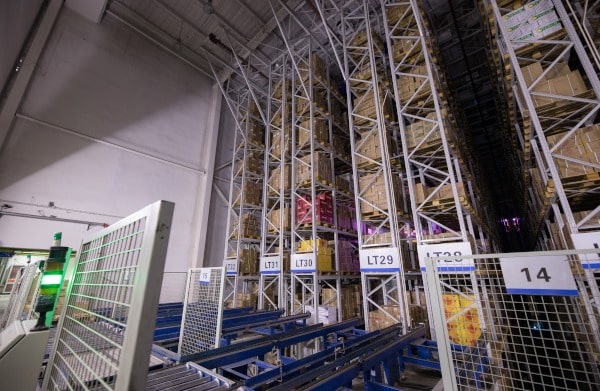What is an automated warehouse or automated storage system?
Automated warehouse: efficient control of (small) parts of all kinds
When it comes to optimizing processes and, in particular, making them more efficient, automated warehouses form a sound basis. The production volume in the area of conveyor technology and intralogistics has been increasing for years and is now at more than EUR 22 billion in Germany alone (2019) – meaning that this segment has grown by more than 50 percent in less than a decade (2010: EUR 14.8 billion). This includes industrial trucks, cranes and hoists, series hoists, logistics software, continuous conveyors and warehouse equipment.
The point is: an automated warehouse, with which internal material and goods flows can be organized better, controlled and handled, is now indispensable in industry and trade alike. We explain the classic structure, how warehouse control works and the most important aspects of automated warehouse systems.
What exactly is an automated warehouse?
The term acts as a generic term and covers all systems and solutions that can be used to automate and optimize warehouses. Depending on the type of goods in question, this refers to both storage and retrieval machines and fully automated systems.
Task and function of an automatic storage system:
- Storage and retrieval of certain goods using pre-assembled pallets, cartons or containers
- Automation of distribution steps
Important: When we talk about an automated warehouse, we are usually referring to the automated small parts warehouse (AKL). It enables safe, space-saving storage that utilizes the full room height and is fully automated.
The typical structure of an automated small parts warehouse (AKL)
Whether tools, machines or other equipment: secure, reliable allocation and provision is the basis for smooth internal processes. For this to work, such an automated storage system is based on boxes or shelves that are specifically targeted.
The highlight: an automated warehouse combines not only racking and the necessary mechanics, but also the control unit in the form of the warehouse management software in one and the same system. Unlike traditional storage solutions, the product can be transported to the user without barriers – and not the other way around. This saves time, increases the efficiency of processes and makes the entire warehouse management more economical.
This is how an automated storage system for small parts is structured as standard:
- Shelving system with differently dimensioned aisles, depending on the intended use
- One storage and retrieval unit (RBG) per aisle as a control element
- Optional boxes, containers, trays etc. for storing the individual articles
- Different number of operating stations for order pickers
- An integrated conveyor system enables each individual article to be transported to the respective order picker
The decisive factor: Removal orders can be easily generated via the respective control software. This reduces the administrative effort and at the same time eliminates sources of error that repeatedly lead to expensive interruptions to operations in non-automated warehouses.
Interesting facts about the warehouse control of an automated warehouse
A special control unit is needed to make the system usable in the first place. The automated warehouse system, i.e. the software linked to the hardware, is therefore the warehouse management system. It can be used to control not only tasks relating to incoming goods, but also aspects such as forklift control, order picking and outgoing goods.
In short, the automated warehouse is the basic structure within which intralogistics processes can be controlled and designed to meet requirements. This makes it possible to optimize the entire process chain, which in turn results in a wide range of benefits.
Advantages of using an automated warehouses:
- Automation of all storage tasks
- Space-saving integration thanks to full utilization of the room height
- Scalable and therefore adaptable to operational requirements
- Transparent processes, reducing or completely eliminating sources of error
- High handling capacity even with a diverse product range
- Optional structuring in the form of single or multi-user storage
- Reduced access times result in shorter delivery times
Put simply: An automated small parts warehouse (AKL) enables fully automated operation and control by means of storage and retrieval machines or so-called shuttles (driverless transportation system).
Selected aspects in favor of implementing automated warehouses
As every company has different objectives and different basic requirements, automated warehouses are generally made to measure. At least in the sense that there is a modular structure. This is intended to take account of the fact that subsequent adjustments (expansion of capacities and/or changes to the system structure) are possible.
The following principle applies: the more flexible the design of such an automated warehouse, the more complex and expensive it is to implement.
So-called adaptive automation systems, which are based on a fundamental algorithm and adapt to new situations and tasks on a self-learning basis, are used increasingly in industry. As internal logistics costs often account for more than ten percent of annual turnover, particularly in industry, the potential synergy effects are enormous.
Other factors that should not be ignored when evaluating automated warehouses:
This means that processes can be made more dynamic and cost-efficient thanks to intelligent, automated warehouse control. This in turn has an impact on margins and competitiveness in an increasingly competitive market.
